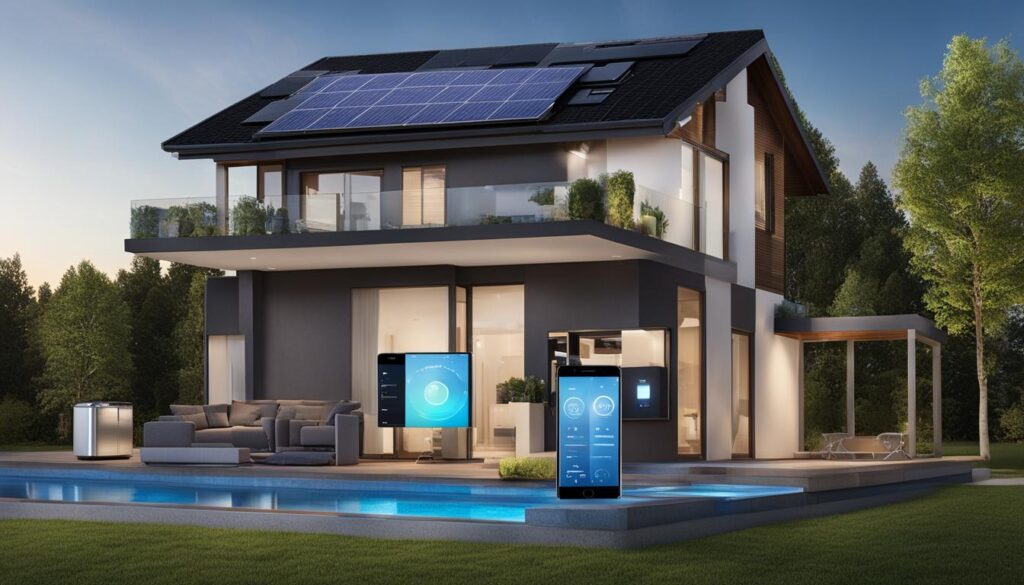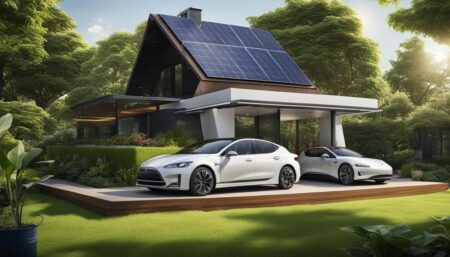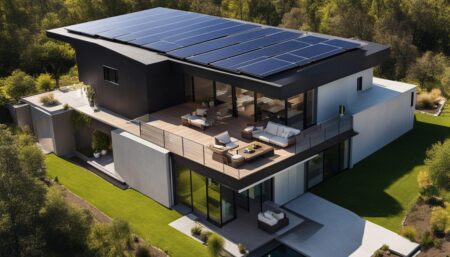Welcome to our comprehensive guide on smart home energy management systems! In this article, we will explore energy-efficient smart home solutions that can help you save on energy costs while enjoying the benefits of smart home automation. By integrating smart devices and technologies, these systems provide homeowners with the ability to monitor and control their energy usage, leading to significant energy savings and increased comfort.
Key Takeaways:
- Smart home energy management systems offer energy-efficient solutions for homeowners.
- These systems integrate smart devices and technologies to monitor and control energy usage.
- Benefits include reduced energy costs and a more sustainable lifestyle.
- Key components include smart thermostats, smart plugs, and energy monitoring and control systems.
- Occupancy detection plays a crucial role in targeted energy savings.
What are Smart Home Energy Management Systems?
Smart home energy management systems are a combination of smart devices and technologies designed to help homeowners monitor and control their energy usage effectively. These systems include energy monitoring and control systems that track the energy consumption of various appliances and devices in the home, providing real-time data for informed decision-making and optimized energy usage patterns.
With smart home energy management systems, homeowners can actively manage their energy consumption, leading to significant cost savings and a more sustainable lifestyle. Let’s take a closer look at how these systems work and the benefits they offer.
How Smart Home Energy Management Systems Work
Smart home energy management systems operate by integrating smart devices and technologies to monitor and control energy usage. These systems employ advanced algorithms and automation to optimize energy consumption based on occupancy and user preferences. By automatically adjusting energy usage patterns and notifying homeowners of energy-saving opportunities, smart home energy management systems help reduce energy waste and promote a more sustainable lifestyle.
By providing real-time energy consumption data, these systems empower homeowners to make informed decisions about their energy usage. They can monitor energy consumption on a device-by-device basis and identify high-energy-consuming appliances or devices. Armed with this knowledge, homeowners can take steps to optimize their energy usage, such as replacing inefficient appliances, adjusting usage patterns, or implementing energy-saving settings on smart devices.
For example, let’s say a homeowner notices that their air conditioning system consumes a significant amount of energy during certain periods of the day. Using a smart home energy management system, they can schedule the system to operate at more energy-efficient settings during those periods or set up automation to adjust the temperature based on occupancy. These small changes can make a significant difference in energy savings over time.
The Role of Energy Monitoring and Control Systems
Energy monitoring and control systems form an integral part of smart home energy management systems. These systems utilize sensors, smart meters, and intelligent software to provide homeowners with real-time energy usage data. By tracking energy consumption at both a whole-house and individual device level, homeowners gain valuable insights into their energy usage patterns and can identify areas for improvement.
Energy monitoring and control systems enable homeowners to:
- Track real-time energy consumption
- Identify high-energy-consuming appliances or devices
- Set energy-saving goals and receive notifications
- Monitor the effectiveness of energy-saving measures
By having a clear understanding of their energy usage, homeowners can take proactive steps to reduce waste and make energy-saving choices. Additionally, some energy monitoring and control systems allow users to set up customized energy usage reports, enabling them to track their progress over time and measure the impact of their energy-saving efforts.
The Benefits of Smart Home Energy Management Systems
Smart home energy management systems offer numerous benefits, providing homeowners with enhanced control over their energy consumption and the ability to save on energy costs. These systems promote energy efficiency and sustainability while improving overall comfort and convenience.
Key benefits of smart home energy management systems include:
| Benefit | Description |
|---|---|
| Energy Savings | By optimizing energy usage patterns and identifying inefficient devices, homeowners can significantly reduce their energy consumption and save on utility bills. |
| Increased Comfort | Smart home energy management systems allow homeowners to create personalized settings for temperature, lighting, and other factors to ensure optimal comfort throughout the day. |
| Sustainability | Reducing energy consumption not only saves money but also helps to reduce greenhouse gas emissions and minimize environmental impact. |
| Convenience | With remote access and control, homeowners can manage their energy usage from anywhere, giving them greater flexibility and convenience. |
Overall, smart home energy management systems empower homeowners to take active control of their energy consumption, leading to cost savings, increased comfort, and a more sustainable lifestyle. In the following sections, we will explore the key components of these systems, the benefits of energy-efficient smart appliances, and the future of smart home energy management.
Benefits of Smart Home Energy Management Systems

Smart home energy management systems offer numerous benefits that contribute to energy efficiency and a more sustainable lifestyle. By integrating energy-efficient smart appliances, smart thermostats, and energy-saving smart lighting systems, these systems empower homeowners to reduce energy consumption and lower their energy costs. Let’s explore the key advantages provided by these innovative solutions.
1. Energy-Efficient Smart Appliances
Energy-efficient smart appliances play a crucial role in reducing energy consumption in households. These appliances are designed to optimize energy usage while maintaining high performance and functionality. By incorporating advanced technologies and features such as energy-saving modes, intelligent power management, and efficient cooling systems, smart appliances significantly cut down on electricity usage without compromising on convenience or productivity.
For example, energy-efficient smart refrigerators use advanced sensors and algorithms to regulate temperature settings based on the needs of stored food, reducing energy waste. Dishwashers with smart features can assess the load size and adjust water and energy consumption accordingly, optimizing efficiency. By utilizing smart appliances, homeowners can save both energy and money in the long run.
2. Smart Thermostats for Energy Management
Smart thermostats are essential components of smart home energy management systems. These devices enable homeowners to regulate their HVAC systems more effectively, resulting in optimized energy usage and increased comfort. With features like programmable schedules, occupancy detection, and remote control via smartphone apps, smart thermostats empower users to customize their heating and cooling patterns based on their lifestyle and preferences, avoiding unnecessary energy consumption.
For instance, by setting different temperature levels for various times of the day or when the home is unoccupied, homeowners can avoid heating or cooling an empty house, leading to significant energy savings. Additionally, some smart thermostats can learn user behavior and adjust settings automatically, maximizing energy efficiency and reducing waste.
3. Energy-Saving Smart Lighting Systems
Energy-saving smart lighting systems offer efficient and automated lighting solutions that adapt to occupancy and natural light availability. These systems utilize occupancy sensors and daylight harvesting features to intelligently control lighting, minimizing energy usage while ensuring adequate illumination. By automatically turning off lights when a room is unoccupied or adjusting brightness levels based on natural sunlight, smart lighting systems prevent unnecessary energy waste.
Moreover, smart lighting systems often come with additional features such as customizable scheduling, color temperature adjustment, and integration with other smart home devices. This integration enables users to create personalized lighting scenes, enhance ambiance, and further optimize energy consumption based on their specific needs and preferences.
Overall, the implementation of energy-efficient smart appliances, smart thermostats, and energy-saving smart lighting systems provides homeowners with tangible benefits, including:
- Reduced energy costs
- Enhanced comfort and convenience
- Lower environmental impact
- Informed energy consumption decisions
- Increased control over energy usage
Embracing smart home energy management systems is a step towards a more sustainable and energy-efficient lifestyle, benefiting both homeowners and the environment.
Key Components of Smart Home Energy Management Systems
Smart home energy management systems are made up of various key components that work together to optimize energy usage and maximize efficiency. These components include:
-
Smart Thermostats
Smart thermostats are intelligent devices that allow homeowners to control and manage their heating and cooling systems more efficiently. They use advanced algorithms and sensors to regulate temperature settings based on occupancy and user preferences, resulting in significant energy savings.
-
Smart Plugs
Smart plugs are WiFi-enabled devices that can be inserted into traditional electrical outlets. They allow homeowners to remotely monitor and control the power supply to connected appliances and devices. By turning off unnecessary devices when not in use, smart plugs help eliminate energy waste and reduce electricity bills.
-
Smart Lighting Controls
Smart lighting controls enable homeowners to automate and customize their lighting systems for maximum energy efficiency. These controls may include dimmers, occupancy sensors, and timers that adjust the lighting levels based on natural light availability and occupancy. By optimizing lighting usage, smart lighting controls contribute to significant energy savings.
These smart devices for energy management are integrated with energy monitoring and control systems that provide real-time data on energy consumption. The data collected helps homeowners gain insights into their energy usage patterns and make informed decisions to further optimize efficiency.
Additionally, smart home energy management systems often include energy monitoring apps that allow homeowners to monitor and control their energy usage remotely. These apps provide a user-friendly interface where homeowners can access real-time energy consumption data, receive notifications about energy-saving opportunities, and adjust settings accordingly.
“With the integration of smart thermostats, smart plugs, and smart lighting controls, homeowners can have full control over their energy usage and achieve significant energy savings.”
– Expert in smart home energy management systems
By combining these key components, smart home energy management systems empower homeowners to take control of their energy usage, minimize waste, and promote a more sustainable lifestyle.
| Key Components | Description |
|---|---|
| Smart Thermostats | Intelligent devices that regulate temperature settings based on occupancy and user preferences, resulting in energy savings. |
| Smart Plugs | WiFi-enabled devices that allow remote monitoring and control of connected appliances, eliminating energy waste. |
| Smart Lighting Controls | Controls and sensors that adjust lighting levels based on natural light availability and occupancy, maximizing energy efficiency. |
How Smart Home Energy Management Systems Work

Smart home energy management systems revolutionize the way we control and optimize energy usage in our homes. By integrating cutting-edge technologies and advanced automation, these systems provide energy-efficient smart home solutions and enable significant energy savings. Let’s explore how these systems work and how they contribute to smart home automation for energy savings.
At the heart of smart home energy management systems are the integration of various smart devices and advanced algorithms. These devices, such as smart thermostats, smart plugs, and smart lighting controls, are connected to an energy monitoring and control system that collects real-time data on energy consumption. With this data, the system can analyze energy usage patterns, identify inefficiencies, and automate adjustments to optimize energy consumption.
Using advanced algorithms, smart home energy management systems can determine occupancy and adjust energy usage accordingly. For example, when a room is unoccupied, the system can automatically turn off lights and adjust temperature settings to conserve energy. This occupancy-based optimization control ensures that energy is only consumed when needed, resulting in energy savings and reduced environmental impact.
Furthermore, smart home energy management systems notify homeowners of energy-saving opportunities and provide real-time insights into their energy consumption. Through user-friendly interfaces and mobile apps, homeowners can monitor and control their energy usage remotely, making informed decisions about their energy consumption.
“Smart home energy management systems provide homeowners with the power to take control of their energy usage, ultimately leading to energy savings and a more sustainable lifestyle.”
Let’s take a closer look at the key components involved:
| Component | Description |
|---|---|
| Smart Devices | A range of smart devices, such as smart thermostats, smart plugs, and smart lighting controls, are used to monitor and control energy usage. |
| Energy Monitoring and Control Systems | These systems collect real-time data on energy consumption and enable automated adjustments to optimize energy usage patterns. |
| Advanced Algorithms | Using algorithms, the system analyzes energy usage patterns, identifies inefficiencies, and automates adjustments to optimize energy consumption based on occupancy and user preferences. |
| Mobile Apps and User Interfaces | User-friendly interfaces and mobile apps provide homeowners with real-time insights into their energy consumption, allowing them to monitor and control their energy usage remotely. |
By leveraging these components, smart home energy management systems create a seamless and efficient energy management ecosystem in the home. Homeowners can enjoy the benefits of an energy-efficient smart home, reducing energy waste, lowering utility bills, and contributing to a more sustainable future.
With their ability to optimize energy consumption based on occupancy and user preferences, smart home energy management systems play a crucial role in smart home automation for energy savings. These systems pave the way for a more sustainable future by empowering homeowners to make informed decisions about their energy usage while enjoying the convenience and comfort of a smart home.
The Role of Occupancy Detection in Energy Savings
Occupancy detection plays a crucial role in maximizing energy savings within smart home energy management systems. By incorporating smart devices equipped with occupancy sensors, homeowners can optimize energy usage based on the presence or absence of occupants in a room or area.
These smart home devices for energy management, such as motion sensors, can accurately detect when individuals enter or leave a space. As a result, energy monitoring and control systems can make informed decisions and adjust energy consumption accordingly, leading to significant energy savings.
“Occupancy detection is a key feature that enables targeted energy savings by turning off lights or adjusting temperature settings in unoccupied areas,” says Mark Thompson, a leading expert in smart home energy management systems. “By ensuring that energy is only consumed when needed, homeowners can reduce wastage and promote a more sustainable lifestyle.”
Occupancy-based optimization control is a fundamental component of smart home energy management systems. It allows for precise and automated energy management, providing optimal comfort and energy efficiency.
One example of occupancy-based optimization control is the integration of smart lighting systems. These systems can automatically turn off lights in unoccupied areas, eliminating energy waste and reducing monthly utility bills. Additionally, by leveraging occupancy detection, smart thermostats can adjust temperature settings based on occupancy patterns, further enhancing energy savings.
Implementing occupancy detection in energy management systems offers homeowners the ability to make targeted adjustments to their energy consumption. By avoiding unnecessary energy usage when rooms or areas are unoccupied, occupants can contribute to a more eco-friendly and cost-effective home environment.
Benefits of Occupancy Detection:
- Reduces energy waste by automatically adjusting energy usage based on occupancy patterns
- Increases energy savings by turning off lights and adjusting temperature settings in unoccupied areas
- Promotes a more sustainable lifestyle by encouraging conscious energy consumption
- Enhances overall comfort and convenience by automating energy management processes
Integrating occupancy detection into smart home energy management systems allows homeowners to optimize their energy usage and lower their environmental impact. By leveraging the capabilities of smart devices and energy monitoring and control systems, occupancy-based optimization control enables targeted energy savings and contributes to a more sustainable future.
Smart Home Energy Management System Packages

When it comes to energy management technology for smart homes, smart home energy management system packages provide comprehensive solutions for homeowners looking to maximize their energy savings. These packages include a combination of energy-efficient smart devices that cover essential areas of energy management throughout the home.
Typically, smart home energy management system packages include:
- ENERGY STAR certified smart thermostats
- Energy-efficient lighting fixtures or bulbs
- Smart plugs
- Devices for optimizing hot water heater usage
By integrating these smart devices, homeowners can have greater control over their energy consumption and reduce their overall energy costs. Let’s take a closer look at the key components included in these packages:
HVAC Control
Smart thermostats, such as the popular Nest Learning Thermostat, are often included in smart home energy management system packages. These thermostats not only provide precise temperature control but also learn the homeowner’s preferences and adjust the HVAC system accordingly. By optimizing the heating and cooling of the home, homeowners can achieve significant energy savings without compromising comfort.
Lighting Control
Energy-efficient lighting solutions are an essential part of smart home energy management system packages. These packages may include smart lighting fixtures or bulbs that utilize LED technology. Smart lighting systems allow homeowners to control and automate their lighting usage, adjusting brightness, color temperature, and even scheduling lights to turn on and off at specific times. By optimizing lighting usage, homeowners can reduce energy waste and enhance the ambiance of their homes.
Monitoring of Miscellaneous Electrical Loads (MELs)
Miscellaneous Electrical Loads (MELs) refer to devices that consume energy when not in active use, such as TVs, gaming consoles, and chargers. Smart home energy management system packages often include smart plugs that allow homeowners to turn off these devices remotely or schedule them to power down when not needed. By managing MELs more efficiently, homeowners can prevent standby power consumption and save energy.
Optimizing Hot Water Heater Usage
The heating of water accounts for a significant portion of a household’s energy consumption. Smart home energy management system packages may include devices that optimize the usage of hot water heaters. These devices can schedule heating cycles during off-peak hours or intelligently adjust temperature settings based on occupancy patterns. By optimizing hot water heater usage, homeowners can reduce energy waste and lower their utility bills.
With the inclusion of these components, smart home energy management system packages provide homeowners with the tools they need to create a more energy-efficient and sustainable home. These packages bring together energy-efficient smart devices, such as smart thermostats, lighting controls, and plugs, to offer comprehensive energy management solutions that maximize energy savings throughout the home.
Table: Smart Home Energy Management System Package Components
| Component | Description |
|---|---|
| Smart Thermostats | ENERGY STAR certified thermostats that provide precise temperature control and learn the homeowner’s preferences. |
| Energy-Efficient Lighting Fixtures or Bulbs | Smart lighting solutions that utilize LED technology and offer customizable control and automation features. |
| Smart Plugs | Devices that allow homeowners to remotely control and automate the power usage of miscellaneous electrical loads (MELs). |
| Devices for Optimizing Hot Water Heater Usage | Smart devices that optimize the usage of hot water heaters, reducing energy waste and lowering utility bills. |
By opting for smart home energy management system packages, homeowners can take a proactive approach towards energy efficiency, ultimately contributing to a more sustainable future.
Qualification Criteria for ENERGY STAR Certification
ENERGY STAR certification is a prestigious recognition for smart home energy management systems that meet specific qualification criteria. By achieving this certification, homeowners can have confidence in the energy efficiency and performance of their systems. Let’s explore the key criteria that must be met for ENERGY STAR certification.
1. Use of ENERGY STAR Certified Devices
An essential requirement for ENERGY STAR certification is the utilization of ENERGY STAR certified devices within the smart home energy management system. These devices, such as smart thermostats and energy-efficient lighting fixtures, have undergone rigorous testing to meet strict energy efficiency standards set by the Environmental Protection Agency (EPA). By incorporating these devices, homeowners can be assured of optimal energy savings and performance.
2. Occupancy Detection and Optimization
A crucial aspect of an ENERGY STAR certified smart home energy management system is its ability to detect occupancy and optimize device operation accordingly. This means that the system must have sensors or mechanisms in place to detect when occupants are present in a room or area. By collecting data on occupancy and optimizing device settings based on occupancy patterns, the system can minimize energy waste and maximize energy savings.
3. Integration with Home Energy Systems
In order to be ENERGY STAR certified, a smart home energy management system must be capable of integrating with other home energy systems, such as hot water heaters. This integration allows for better coordination and control of energy usage throughout the home. By connecting and communicating with these systems, the smart home energy management system can optimize energy consumption and further enhance overall energy efficiency.
4. Installation Instructions and Recommendations
ENERGY STAR certification emphasizes the importance of providing clear and comprehensive installation instructions and recommendations. These instructions should guide homeowners in properly installing and setting up the smart home energy management system to maximize energy savings. By following these instructions, homeowners can ensure the system operates at its full potential and achieves the desired energy efficiency outcomes.
Meeting the qualification criteria for ENERGY STAR certification ensures that smart home energy management systems deliver energy-efficient solutions for homeowners. By utilizing ENERGY STAR certified devices, integrating with home energy systems, and incorporating occupancy detection and optimization capabilities, these systems can provide significant energy savings and promote sustainability. Let’s strive for ENERGY STAR certification to unlock the full potential of energy-efficient smart home solutions.
Evaluation Methodology for Smart Home Energy Management Systems

In order to measure the energy-saving capabilities of smart home energy management systems, a comprehensive evaluation methodology is employed. This evaluation methodology involves collecting field data to assess the effectiveness of these systems in achieving energy efficiency and promoting sustainable practices.
The evaluation process includes the gathering of essential information, such as the number and type of installed devices, energy consumption metrics, and user interaction. This data provides valuable insights into the performance and efficiency of energy management systems within a smart home environment.
By analyzing the collected data, certification bodies are able to verify the energy-saving capabilities of these systems. The analysis helps assess the overall effectiveness of the implemented energy management technology in achieving energy-efficient smart home solutions.
In order to maintain ENERGY STAR certification, continuous monitoring and periodic data submissions are required. This ensures that the certified smart home energy management systems consistently meet the established energy-efficient standards.
The evaluation methodology for smart home energy management systems is crucial in providing homeowners with reliable information about the energy-saving capabilities of these technologies. This helps them make informed decisions when choosing energy management solutions for their homes.
“The evaluation methodology for smart home energy management systems provides valuable insights into their energy savings potential, enabling homeowners to make informed decisions and contribute to a sustainable future.”
By continually improving the evaluation process, energy management technology for smart homes can further enhance energy-efficient smart home solutions. This ongoing evaluation ensures that the advancements in energy-saving smart lighting systems and other technologies are effectively integrated into smart homes, leading to increased energy savings and reduced environmental impact.
Interoperability and Connectivity in Smart Home Energy Management Systems
Interoperability and connectivity play a vital role in the effectiveness of smart home energy management systems. These systems aim to seamlessly integrate various smart devices, including appliances, lighting controls, and heating systems, to enable efficient communication and control. By leveraging open standards and communication protocols like Wi-Fi, SEP, and Bluetooth, these systems ensure compatibility and easy integration with other devices, promoting a comprehensive approach to energy management and optimization in smart homes.
Smart home energy management systems are designed to work harmoniously with a wide range of smart devices, allowing homeowners to centralize control and monitor their energy usage effectively. Whether it’s controlling the thermostat remotely through a smartphone or coordinating lighting controls based on occupancy, interoperability enables homeowners to manage their energy consumption effortlessly.
By integrating various smart devices, smart home energy management systems provide homeowners with centralized control and monitoring capabilities. For example, a single app can control the thermostat, lighting, and other devices to optimize energy usage and create a comfortable living environment. The interoperability of these devices ensures seamless communication and coordination, allowing homeowners to effortlessly manage their energy consumption and reduce utility costs.
“Smart home energy management systems integrate various devices, enabling homeowners to conveniently monitor and control their energy usage across different areas of the house. This interoperability ensures a cohesive energy management experience, promoting energy efficiency and savings.”
Furthermore, interoperability enables homeowners to expand their smart home ecosystem with ease. As new smart devices and technologies emerge, homeowners can effortlessly integrate them into their existing energy management systems, further enhancing their capabilities. This flexibility ensures that smart homes remain adaptable and future-proof, ready to embrace the latest advancements in energy management technology for even greater energy savings.
Enhancing Connectivity with Communication Protocols
To ensure seamless communication and control among smart devices, smart home energy management systems rely on a variety of communication protocols. These protocols facilitate the exchange of data and commands between devices, enabling centralized control and coordination.
Some commonly used communication protocols in smart homes include:
- Wi-Fi: Wi-Fi provides wireless connectivity between devices, allowing for easy remote control and monitoring. With Wi-Fi compatibility, homeowners can conveniently manage their energy usage through smartphone apps or web-based portals.
- SEP (Smart Energy Protocol): SEP is an open standard protocol specifically designed for smart grid and smart home applications. It enables secure and reliable communication between energy management devices, facilitating efficient energy management and optimization.
- Bluetooth: Bluetooth technology enables short-range wireless communication, making it suitable for connecting devices within close proximity. It is commonly used for controlling smart lighting systems, entertainment systems, and other local devices.
The Benefits of Interoperability and Connectivity
The interoperability and connectivity provided by smart home energy management systems offer several benefits for homeowners:
- Efficiency: The seamless integration of smart devices enables homeowners to optimize their energy usage, reducing waste and promoting energy efficiency throughout the home.
- Convenience: With centralized control and monitoring capabilities, homeowners can easily manage their energy consumption from a single interface, whether they are at home or away.
- Flexibility: Interoperability allows for the easy integration of new devices and technologies, ensuring that smart homes remain adaptable to future advancements.
- Savings: By effectively managing and optimizing energy usage, smart home energy management systems can lead to significant cost savings on utility bills over time.
Overall, the interoperability and connectivity offered by smart home energy management systems enable homeowners to create a seamlessly connected and efficient living environment. By integrating various smart devices and leveraging communication protocols, these systems empower homeowners to take control of their energy consumption, reduce waste, and promote a more sustainable and cost-effective lifestyle.
Preparation for the Future of Smart Home Energy Management Systems
As the smart home industry continues to advance, it is vital for homeowners and electrical suppliers to proactively prepare for the future of energy-efficient smart home solutions. Staying informed about changing architectural and communication requirements, adopting standard protocols and certification standards, and investing in compatible smart home devices for energy management is crucial for embracing the advancements in energy management technology. By doing so, homeowners can ensure their homes are equipped to participate in future energy markets and demand response services.
Staying Ahead of the Curve
In an ever-evolving industry, it is important to stay ahead and adapt to the changing landscape of smart home energy management systems. By staying informed about the latest technological advancements and industry trends, homeowners can make educated decisions about the smart home devices and energy management technology for their homes.
One way to prepare for the future of energy-efficient smart home solutions is by understanding the changing architectural requirements. As new technologies emerge, it is essential to consider the compatibility of existing systems and infrastructure. By planning ahead and ensuring the home’s infrastructure supports the integration of smart home devices, homeowners can easily incorporate energy management technology for smart homes.
Adopting Standard Protocols and Certification Standards
To ensure seamless interoperability and connectivity, it is crucial to adopt standard protocols and certification standards in smart home energy management systems. Open standards and communication protocols, such as Wi-Fi, SEP, and Bluetooth, facilitate the integration of smart devices with energy management technology. By adhering to these standards, homeowners can maximize the compatibility of their smart home devices for energy management and ensure a cohesive and efficient energy management system.
Moreover, seeking ENERGY STAR certification for smart home energy management systems is advantageous. ENERGY STAR certification guarantees the use of energy-efficient smart home solutions and encourages optimal energy management. By complying with the qualification criteria set by ENERGY STAR, homeowners can enjoy the benefits of verified energy savings and make informed decisions when selecting energy-efficient smart home devices.
Investing in Compatible Smart Home Devices and Technologies
The future of smart home energy management systems heavily relies on well-equipped homes with compatible smart home devices for energy management. Homeowners should consider investing in smart devices that align with their energy-saving goals and preferences. These devices may include smart thermostats, smart lighting controls, and other advanced energy management technologies that provide efficient control and monitoring capabilities.
An important aspect to consider when purchasing smart home devices is their integration capabilities. Ensuring compatibility with established protocols and communication standards will facilitate the seamless connection and operation of the smart devices within the energy management system.
Remember, adopting energy management technology for smart homes requires a proactive approach. By preparing for the future, homeowners can unlock the full potential of energy-efficient smart home solutions, optimize energy usage, reduce costs, and contribute to a sustainable lifestyle.
“The best way to predict the future is to create it.” – Peter Drucker
The Future of Smart Home Energy Management Systems
The future of smart home energy management systems holds great potential for further advancements in energy efficiency and automation. With ongoing innovations in technology, such as machine learning algorithms and artificial intelligence, smart home energy management systems will become even more sophisticated in optimizing energy usage. This will lead to greater energy savings, improved comfort, and increased sustainability for homeowners.
Advancements in energy-efficient smart home solutions will allow homeowners to have better control over their energy consumption. Smart home automation for energy savings will become more intuitive and responsive, adapting to homeowners’ habits and preferences to reduce unnecessary energy usage.
Energy management technology for smart homes will continue to evolve, enabling homeowners to monitor and adjust their energy usage in real-time. With the integration of smart devices, energy monitoring and control systems, and advanced algorithms, homeowners will have a comprehensive solution for managing their energy consumption effectively.
In the future, smart home energy management systems will be capable of analyzing energy usage patterns and making intelligent decisions to optimize energy efficiency. Machine learning algorithms will learn from homeowners’ behaviors and patterns, automatically adjusting energy consumption settings to minimize waste and maximize savings.
This increased sophistication in smart home energy management systems will also extend to energy storage solutions. Homeowners will have the ability to store excess energy generated from renewable sources, such as solar panels, and use it during peak energy demand periods or in the event of a power outage.
Furthermore, advancements in smart grid integration will enable smart home energy management systems to participate in demand response programs. These programs incentivize homeowners to reduce their energy usage during peak demand periods, contributing to overall grid stability and reliability.
As smart home energy management systems continue to evolve, interoperability will be a key focus. Interconnected devices will seamlessly communicate with each other to optimize energy usage, ensuring that different components work together harmoniously.
To illustrate the potential of future smart home energy management systems, consider the following table showcasing a hypothetical comparison between current and future energy savings:
| Current Systems | Future Systems | |
|---|---|---|
| Energy Savings | 10-15% | 20-30% |
| Comfort | Basic automated settings | Personalized, adaptive comfort |
| Sustainability | Limited integration with renewable energy | Optimal utilization of renewable sources |
This hypothetical comparison highlights the potential for significant improvements in energy savings, comfort, and sustainability with future smart home energy management systems.
In conclusion, the future of smart home energy management systems is bright, with ongoing advancements in technology paving the way for increased energy efficiency, automation, and sustainability. Homeowners can look forward to greater control over their energy consumption, personalized comfort, and a reduced environmental impact.
Conclusion
Smart home energy management systems offer homeowners a comprehensive solution to monitor and control their energy usage, resulting in significant savings and a more sustainable lifestyle. By integrating smart devices, energy monitoring and control systems, and advanced algorithms, these systems provide efficient and convenient energy management solutions.
With the ability to automate and optimize energy consumption, smart home energy management systems enable homeowners to reduce their energy costs while enhancing their comfort. By using energy-efficient smart home solutions, such as smart thermostats and lighting systems, homeowners can maximize their energy savings and contribute to a greener environment.
The future of smart home energy management systems looks promising, with ongoing advancements in technology. As these systems continue to evolve, incorporating machine learning algorithms and artificial intelligence, homeowners can expect even greater energy efficiency and automation. By embracing innovative home automation, homeowners can unlock efficiency, reduce costs, and make a positive impact on the environment.
FAQ
What are smart home energy management systems?
Smart home energy management systems integrate smart devices and technologies to monitor and control energy usage in homes, resulting in significant energy savings and increased comfort.
What are the benefits of smart home energy management systems?
Smart home energy management systems offer numerous benefits, including the use of energy-efficient smart appliances, smart thermostats for energy management, and energy-saving smart lighting systems, which ultimately lead to reduced energy costs and a more sustainable lifestyle.
What are the key components of smart home energy management systems?
Smart home energy management systems consist of a combination of smart devices for energy management, such as smart thermostats, smart plugs, and smart lighting controls. These devices are connected to energy monitoring and control systems that provide real-time data on energy consumption. Smart home energy monitoring apps also allow homeowners to remotely monitor and control their energy usage through their smartphones or other smart devices.
How do smart home energy management systems work?
Smart home energy management systems integrate various smart devices and technologies to monitor and control energy usage. These systems use advanced algorithms and automation to optimize energy consumption based on occupancy and user preferences. By automatically adjusting energy usage patterns and notifying homeowners of energy-saving opportunities, smart home energy management systems help reduce energy waste and promote a more sustainable lifestyle.
What is the role of occupancy detection in energy savings?
Occupancy detection is a critical component of smart home energy management systems. Smart devices equipped with occupancy sensors can detect when occupants are present in a room or area and adjust the energy usage accordingly. This allows for targeted energy savings, such as turning off lights or adjusting temperature settings in unoccupied spaces. Occupancy-based optimization control is a key feature of smart home energy management systems that ensures energy is only consumed when needed.
What do smart home energy management system packages typically include?
Smart home energy management system packages typically include a combination of smart devices that cover essential areas of energy management, such as HVAC control, lighting control, and monitoring of miscellaneous electrical loads (MELs). These packages may include ENERGY STAR certified smart thermostats, energy-efficient lighting fixtures or bulbs, smart plugs, and devices for optimizing hot water heater usage.
What are the qualification criteria for ENERGY STAR certification for smart home energy management systems?
ENERGY STAR certification for smart home energy management systems requires meeting specific qualification criteria. These criteria include the use of ENERGY STAR certified devices, such as smart thermostats and energy-efficient lighting fixtures. The systems must also demonstrate the ability to detect occupancy, collect information on device optimization based on occupancy, and connect to other home energy systems, such as hot water heaters. Additionally, ENERGY STAR certification emphasizes the importance of providing installation instructions and recommendations to promote maximum energy savings.
What is the evaluation methodology for smart home energy management systems?
The evaluation methodology for smart home energy management systems involves collecting field data to demonstrate the systems’ energy-saving capabilities. This data includes information on the number and type of installed devices, energy consumption metrics, and user interaction. By analyzing this data, certification bodies can verify the effectiveness of the systems in achieving energy savings. Continuous monitoring and periodic data submissions are requirements for maintaining ENERGY STAR certification for smart home energy management systems.
Why is interoperability and connectivity important in smart home energy management systems?
Interoperability and connectivity are crucial factors in smart home energy management systems. These systems aim to integrate various smart devices, including appliances, lighting controls, and heating systems, to enable seamless communication and control. By leveraging open standards and communication protocols, such as Wi-Fi, SEP, and Bluetooth, smart home energy management systems ensure compatibility and easy integration with other devices. This interoperability enables comprehensive energy management and optimization throughout the home.
How should homeowners prepare for the future of smart home energy management systems?
As the smart home industry continues to evolve, it is essential for homeowners and electrical suppliers to prepare for the future of smart home energy management systems. This includes being aware of the changing architecture and communication requirements, adopting standard protocols and certification standards, and investing in compatible smart devices and technologies. By embracing these advancements, homeowners can ensure their homes are ready to participate in future energy markets and demand response services.
What does the future hold for smart home energy management systems?
The future of smart home energy management systems holds great potential for further advancements in energy efficiency and automation. With ongoing innovations in technology, such as machine learning algorithms and artificial intelligence, smart home energy management systems will become even more sophisticated in optimizing energy usage. This will lead to greater energy savings, improved comfort, and increased sustainability for homeowners.






